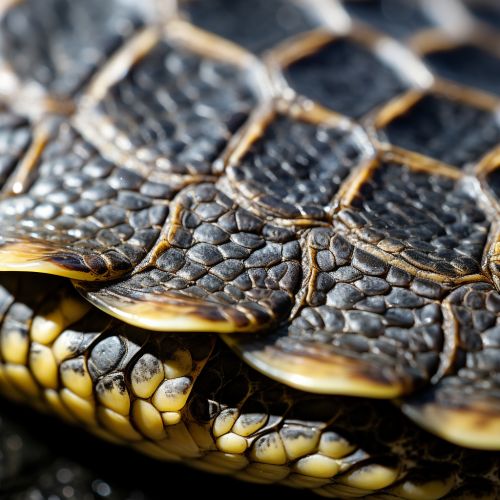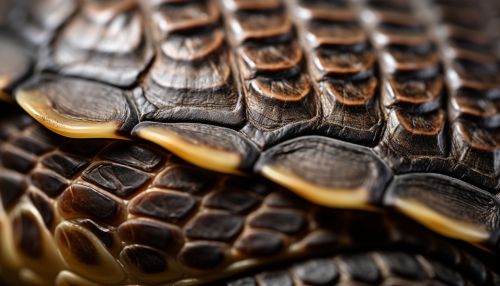Scute
Overview
A scute or scutum (plural: scuta) is a bony, external plate or scale overlaid with horn, as on the shell of a turtle, the skin of crocodilians, and the feet of birds. The term is also used to describe the hard, protective armor of some invertebrates, such as the arthropods. Scutes serve a variety of functions, from protection to aiding in locomotion. They are an integral part of the anatomy of many animals and are a key component in the study of paleontology and herpetology.


Anatomy and Structure
Scutes are typically composed of the protein keratin and are structurally similar to the scales of fish. However, unlike scales, which are overlapping, scutes are typically non-overlapping and form a solid, continuous surface. They are often hexagonal in shape, but can vary greatly depending on the species and the specific location on the body.
Scutes can be found in a variety of shapes and sizes, and their characteristics can often be used to identify the species of an animal. For example, the number and arrangement of scutes on a turtle's carapace (upper shell) and plastron (lower shell) are unique to each species and are often used in identification.
Function
The primary function of scutes is to provide protection. They form a hard, protective layer over the softer tissues of the body, shielding them from predators, environmental hazards, and injury. In some species, such as the crocodile, the scutes are reinforced with bone, making them even more resilient.
In addition to protection, scutes also play a role in locomotion for some animals. For example, the scutes on the legs of birds are used for scratching and digging, while the scutes on the tails of crocodiles assist in propulsion through water.
Evolution
Scutes are believed to have evolved as a form of protection, similar to the way scales and shells have evolved in other animals. The earliest known animals with scutes were the placodonts, a group of marine reptiles that lived during the Triassic period. These animals had large, bony scutes covering their bodies, which likely served as a form of armor against predators.
Over time, scutes have evolved in a variety of ways in different animal groups. For example, in turtles, the scutes have become an integral part of the shell, while in birds, they have become reduced and modified into scales on the feet.
Scutes in Various Animal Groups
Turtles
In turtles, the scutes cover the bony plates of the shell. The carapace is covered with costal scutes, vertebral scutes, and marginal scutes, while the plastron is covered with abdominal, pectoral, femoral, and anal scutes. The arrangement and number of these scutes can be used to identify the species of turtle.
Crocodilians
Crocodilians, which include crocodiles, alligators, and gharials, have bony scutes, known as osteoderms, embedded in their skin. These scutes are especially prominent on the animal's back, giving it a rough, armored appearance. The osteoderms are connected to the animal's immune system and are believed to play a role in fighting infections.
Birds
In birds, scutes are found on the feet and are more commonly referred to as scales. They are most prominent in ground-dwelling birds, such as chickens and turkeys, where they are used for scratching and digging.
